Healthy And Easy Vegan Japchae (Korean Glass Noodles).

Healthy. Gluten free. Delicious.
Vegan japchae.
Japchae is one of the most popular Korean dishes. The noodles are bouncy, chewy, and coated in a sweet and savory sauce.
But I wanted to try making a healthier, easier version, one that you can whip up for a quick and satisfying meal for the entire family, after a long day. If you want the more traditional take on japchae (i.e., my Mom’s recipe, you can find that here).
So, without further ado, let’s get into it!
- What is Japchae?
- Is Vegan Japchae A Longevity Food?
- Things To Keep, Add, and Replace in This Healthy Vegan Japchae.
- Notes on Potential Substitutions for Vegan Japchae.
- How to Make this Healthy Vegan Japchae.
- Shopping List for Vegan Japchae.
- Want a More Traditional Japchae Recipe?
- Frequently Asked Questions.
- Recipe Card.
- Questions & Comments
Disclaimer: Some of the links in this post may be affiliate links for products I use and love. If you make a purchase after clicking one of those links, I may earn a small affiliate commission, perhaps enough to buy some extra gochujang or gochugaru 🙂
What is Japchae?

Often described as “stir-fried glass noodles” or “Korean glass noodles,” Korean japchae consists of long, bouncy noodles that are made out of sweet potato starch, mixed with a variety of vegetables. Because the glass noodles (referred to as “dangmyeon” or “dangmyeon noodles”) are made exclusively from sweet potato starch, they are naturally gluten-free. If you use gluten-free soy sauce, this entire Korean dish is gluten-free.
Walk into your local Korean grocery store, Korean buffet, or other Korean restaurant, and you will almost always see some version of japchae on the menu. Japchae is one of the most popular dishes in Korea. It’s one of my all-time favorite Korean foods, which is probably why I ask for it (or make it myself) every single birthday, Thanksgiving, Christmas, and other special occasions. It is also one of the most popular recipes out of my cookbook.
What makes traditional japchae not vegan? Traditional japchae usually includes beef. Because the japchae sauce is similar to that used to marinate Korean BBQ, oftentimes, traditional japchae incorporates bulgogi (Korean BBQ flank steak). Fancy versions of japchae might also include thin strips of gyerranmari (Korean style omelet). This vegan version of japchae excludes any animal protein and, instead, incorporates a healthy plant-based protein–tofu!
Japchae is one of many “banchan” or side dishes in Korean cuisine that you would typically serve with a small bowl of rice. This may seem a bit odd, since noodles are usually considered to be a main course–even in Korean cuisine (e.g., jjajangmyeon, jjolmyeon, naengmyeon, kimchi guksu). This may be because the noodles are not made from wheat (and thus considered to be lighter than their wheat-based counterparts), but it’s more likely that it has to do with the savory sauce. Like many Korean banchan, the flavor is intense and, as such, requires the neutrality of rice for balance.
That said, this vegan japchae recipe is designed to be a meal in and of itself–though, this Korean vegan is never gonna stop you from grabbin’ a heaping, hot bowl of rice!
Is Vegan Japchae A Longevity Food?
Traditional japchae is already a relatively healthy dish, with the inclusion of so many antioxidant and fiber rich vegetables: red bell pepper, green bell pepper, yellow bell pepper, orange bell pepper, onions, spinach, carrots. However, the inclusion of red meat, the sodium rich soy sauce, and brown sugar or white refined sugar can make even this vegetable forward dish a little heavy or, in some cases, simply not an option.
This vegan japchae recipe takes a lot of the excellent health properties of traditional japchae, adds to them, and then replaces or eliminates some of those ingredients that prevent this dish from becoming part of your weekly rotation of healthy Korean recipes. In other words, this vegan japchae recipe catapults this popular Korean dish to its rightful place as a powerhouse staple of longevity.
Things To Keep, Add, and Replace in This Healthy Vegan Japchae.
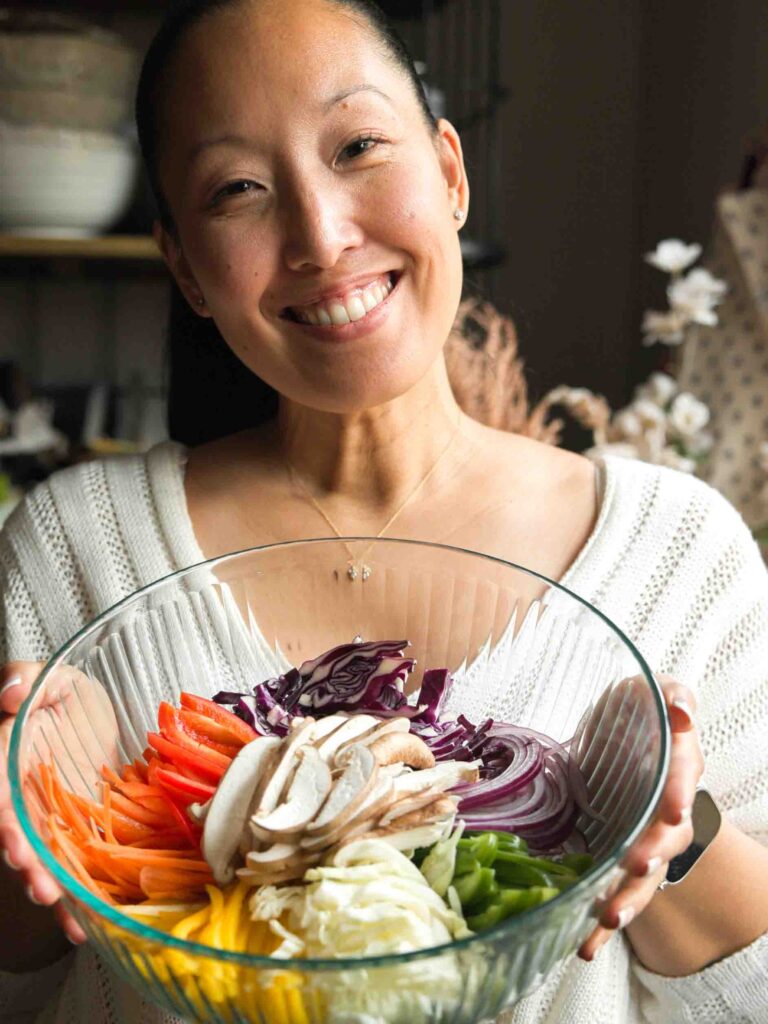
Things to Keep:
- Keep the full rainbow of bell peppers, an excellent source of Vitamin C, potassium, carotenoids, and folate.
- Keep the boiled spinach, rich in antioxidants like neoxanthin and violaxanthin, which may help to slow the formation of cancer cells.
- Keep the Korean sweet potato glass noodles, which does not contain any refined wheat products, but packs a whopping 4 grams of fiber, 475% of your daily value of Vitamin A, and 33% the daily value of Vitamin C per serving!
Things to Add:
- Add purple cabbage, because purple isn’t represented in traditional japchae and we want the full rainbow in our Korean glass noodles. Purple cabbage also contains flavonoids, including resveratrol, which may help boost immunity to certain cancers.
- Add green cabbage, because I love green cabbage (it is literally one of my favorite foods!) and green cabbage contains Vitamin K, which helps keep our bones strong and can prevent bone fractures.
- Add rice vinegar, which not only adds a pleasant tartness to this vegan japchae, but also helps to stabilize blood sugar and insulin.
Things to Remove and Replace:
- Remove beef and replace with baked tofu, which is an excellent source of a complete protein, providing all nine of the essential amino acids.
- Remove the oil used for the stir-fried vegetables and replace with either vegetable broth or water.
- Remove the sugar in the sauce and replace with a non-refined sweetener like maple syrup, which, btw, contains 65 antioxidants and a host of minerals like calcium, manganese, and zinc.
- Remove regular soy sauce and replace with low-sodium gluten-free soy sauce, which can remove up to half the amount of sodium in regular soy sauce.
Yes, that’s right–this vegan japchae recipe puts a new spin on “longevity noodles”!
Notes on Potential Substitutions for Vegan Japchae.
The following are some recommended substitutions to certain ingredients for this vegan japchae:
- Glass Noodles. Although Korean sweet potato starch noodles are an essential component of japchae, if you can’t get your hands on dangmyeon, you can substitute with rice noodles. Try and find some that are similar in width to Korean glass noodles, which are roughly the diameter of spaghetti.
- Soy Sauce. If you are allergic to soy, there are some great no-soy alternatives, including this no-soy, gluten-free sauce sauce. You can, of course, also use coconut aminos.
- Spinach. Traditional japchae utilizes spinach as its source of leafy green, but don’t let that stop you from incorporating your favorite green. I love subbing with kale, broccoli, swiss chard, collard greens, bok choy! You can boil them or stir-fry them–whatever is your pleasure!
- Maple Syrup. You can substitute your favorite unrefined sweetener: brown rice syrup, coconut sugar, date sugar, etc.
- Rice Vinegar. Again, feel free to substitute with your favorite vinegar, one that’s naturally sweet, like apple cider vinegar, raspberry vinegar, etc.
How to Make this Healthy Vegan Japchae.

Believe it or not, traditional japchae is a fairly labor intensive dish. Like vegan kimbap or vegan bibimbap, there are a lot of components to japchae. What’s more is that all of the vegetables are supposed to be stir-fried separately. If you’ve made the japchae recipe out of my cookbook, then you know there’s also a somewhat not-simple way to cook the noodles (involving both cold and hot water).
This vegan japchae recipe aims to simplify the cooking process, so that you can incorporate it into your weekly rotation of family meals. If you want to make a show-stopping dish for your next potluck or dinner party, then go to the recipe in my cookbook. But if you want something delicious but super easy to make, then keep reading!
First, preheat your oven (or air fryer) to 400°. Cut your super firm or extra firm tofu into batons about the width of your pinky finger. Spread them out on a baking sheet lined with parchment paper and place them in your oven. Let them cook for about 20 minutes, until their corners begin to turn brown. You don’t need to cook them until they’re crisp, though you can if you want to.
In the meantime, cook the spinach by bringing a large pot of water to a boil. Drop the spinach in and let it cook for about 1 minute, until the leaves turn a bright and brilliant green. Drain and run the spinach under cold water, to stop it from cooking longer. Squeeze out the excess liquid and set it aside.
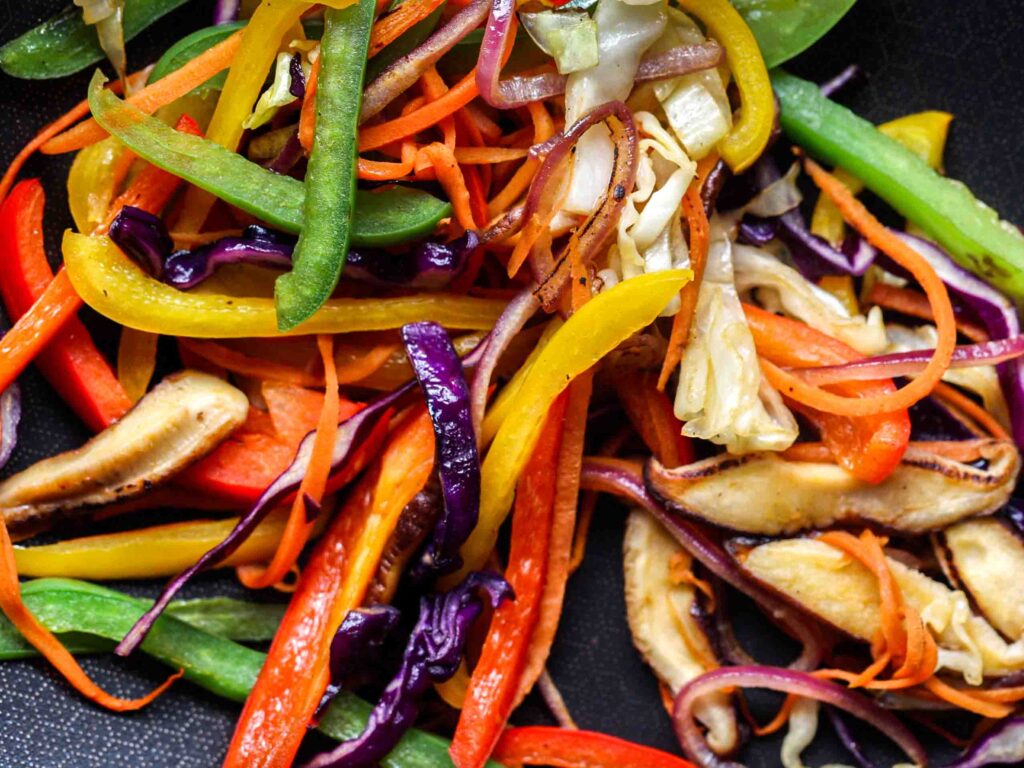
Next, julienne the remaining vegetables. When I’m making japchae for a dinner party, I make sure the vegetables are extremely skinny, almost like my mom is in the kitchen with me and telling me “make them skinnier!” But for this vegan japchae recipe, just chop them into whatever sized matchsticks your knife skills can achieve efficiently and safely.
After you’ve julienned all the vegetables, stir fry them all together in vegetable broth or water, using a very good non-stick pan for about 4 to 5 minutes. Because these vegetables are meant to provide texture to this vegan japcahe, you don’t want to overcook them. You want them to retain some bite. Turn off the heat but keep the veggies in the pan.
Cook the noodles according to package instructions. I like to use a large, deep pan and fill that with water. Bring this to a boil and add your glass noodles. Cook until they are still chewy but not hard–usually about 7 minutes. Before draining the excess water, reserve about 1 cup. Then drain the water, run the noodles under cold water (so they don’t get soggy), and place the noodles in the same pan as the stir-fried vegetables.

To the pan, add the baked tofu, boiled spinach, stir-fried vegetables, low sodium soy sauce, rice vinegar, maple syrup, toasted sesame seeds, black pepper, and a little bit of the reserved water from when you cooked noodles. Turn the heat onto the lowest setting and stir the ingredients together vigorously. This agitation is what will facilitate the combination of starch (noodle water), fat (sesame seeds), and heat to create a “sticky” sauce, one that will adhere to all the noodles and vegetables. Add as much noodle water as you need, though you don’t want your vegan japchae swimming in sauce, just well coated and slick.

Shopping List for Vegan Japchae.
Want a More Traditional Japchae Recipe?

If you want a japchae for those special occasions–birthdays, holidays, potlucks, dinner parties–look no further! Head over to my Mom’s Traditional Japchae Recipe! Chock full of all my mom’s tips and tricks for making the perfect japchae, it’ll knock your socks off, I promise!
Frequently Asked Questions.
Can I make my vegan japchae in advance?
It’s best to prepare your vegan japchae right before you intend to serve it. The longer the noodles are exposed to room temperature, the harder they will become to eat.
How long can I store my vegan japchae?
If you can have leftovers from enjoying your vegan japchae, store them in an airtight container in the refrigerator for up to three days.
How can I reheat leftover vegan japchae?
Leftover vegan japchae can be reheated using the microwave or by stir-frying the leftovers in a little vegetable broth or water in a large pan over medium-high heat.
Recipe Card.
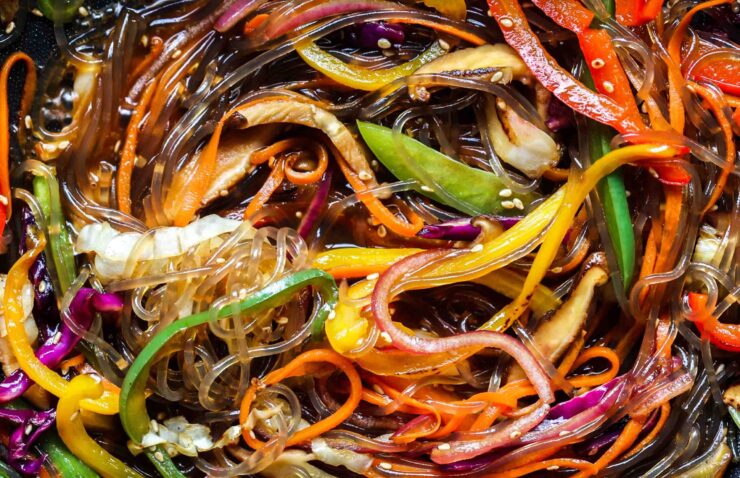
Healthy & Easy Vegan Japchae (Korean Glass Noodles)
Ingredients
- 16 ounce super firm tofu, cut into batons
- 4 cups spinach
- 2 tbsp vegetable broth or water
- 1/4 cup sliced shiitake mushrooms
- 1/4 cup julienned red bell pepper
- 1/4 cup julienned green bell pepper
- 1/4 cup julienned orange bell pepper
- 1/4 cup julienned yellow bell pepper
- 1/4 cup julienned carrot
- 1/4 cup julienned red onion
- 1/4 cup julienned purple cabbage
- 1/4 cup julienned green cabbage
- 2 tsp minced garlic
- 3.5 ounces Korean sweet potato vermicelli
- 2 tbsp low-sodium soy sauce
- 1 tbsp rice vinegar
- 2 tbsp maple syrup
- 1 tsp sesame oil
- 1 tsp cracked black pepper `
Instructions
- Preheat your oven (or air fryer) to 400° F. Spread your tofu batons onto a baking sheet lined with parchment paper. Once your often is preheated, place the baking sheet in the center rack and bake until the corners begin to turn golden brown, around 20 minutes (will be more like 10 minutes in the air-fryer).
- In the meantime, boil your spinach by adding them to a large pot of boiling water. Cook until they turn bright green, about 1 minute. Then drain and run under cold water, to stop the cooking process. Squeeze out any excess liquid and place your spinach aside.
- Stir-fry all the vegetables by adding vegetable broth to a large non-stick wok or skillet over medium high heat. When the broth starts to bubble (about 1 minute), add shiitake mushrooms, all the bell peppers, red onion, scallion, green and purple cabbage, carrot, and garlic. Cook until they just start to soften, about 4 to 5 minutes. Turn off the heat but keep the veggies in the pan.
- Cook your noodles by adding them to boiling water for about 7 minutes. The noodles should be chewy, not hard. Reserve about 1 cup of the cooking water. Then, drain the noodles and run them under cold water. Add these to the pan of stir-fried vegetables.
- Add the baked tofu and spinach to the pan of noodles and veggies. Then, add low-sodium soy sauce, rice vinegar, maple syrup, sesame seeds, black pepper, and a tablespoon or two of the noodle cooking water. Turn the heat onto very low and stir vigorously until all the ingredients are well combined (about 1 to 2 minutes). If your noodles seem dry, add a little more of the cooking liquid. Remove from heat and serve.



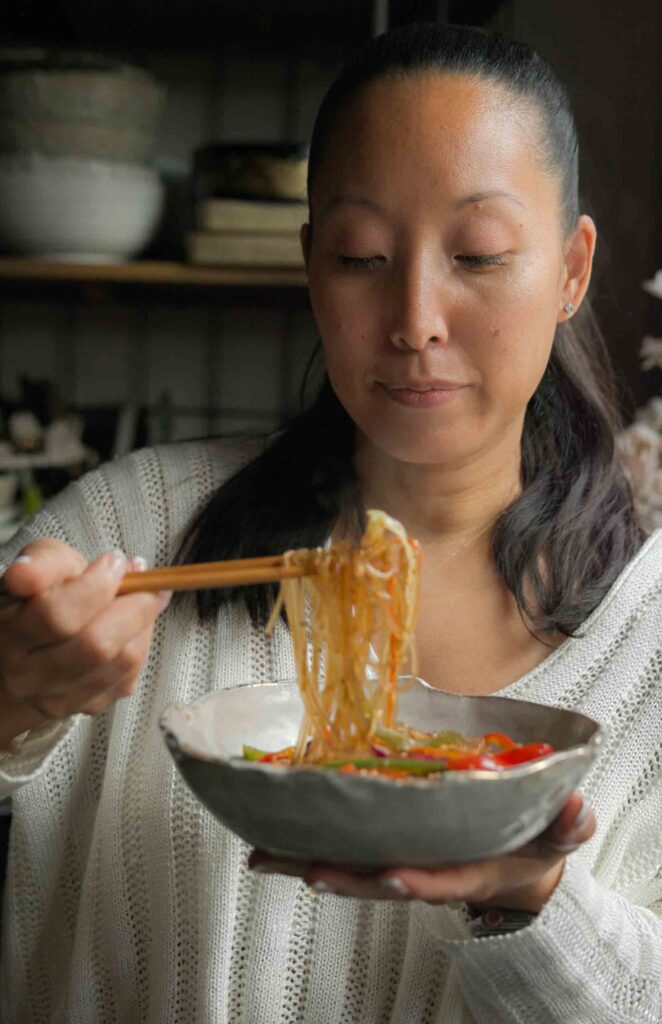


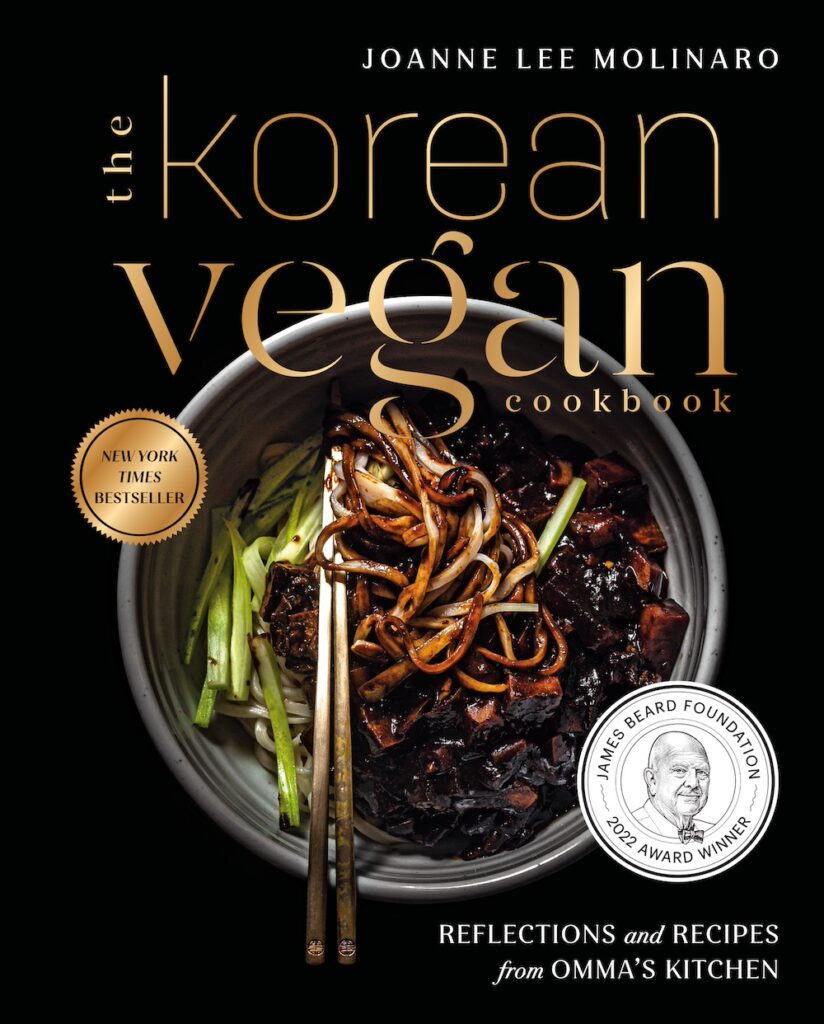
Do you cut up the noodles after you cook them? They are sooooooo long.
I love all your recipes! Big THANK YOU💓
Hello!
A teenie detail is missing. You mention when to add scallion in the instructions, but I don’t see an amount listed in the ingredients.
The recipe I’ve been using to this point doesn’t use rice vinegar, so I’m curious about what it will add! I did feel the other recipe was missing… something and was a bit on the heavy side, so will guess this is the absent ingredient!
Spørgsmål selve Japchae Sovs søger jeg en opskrift til at bruge til divs retter da det kun er små flasker man kan købe med den færdige Japchae Sovs lidt træls at den ikke sælges i større mængde indhold
Is there a way to substitute or simply omit the maple syrup, that isn’t another sugar source?
Japchae traditionally is supposed to be a sweet and savory dish. You can, of course, remove the maple syrup and use LESS soy sauce and still have the sweetness from the vinegar you use. If you want to retain the sweetness, I suggest unrefined sweetener options in the Substitutions section above. If you aren’t comfortable with any of those, then you can also use Stevia.
Ms Joanne, this recipe has everything I look for in a vegan meal. I can’t wait to make it. I hope that you will continue to promote your longevity recipes. Warm regards, EPS
Eleanor! That makes me so so happy!! I can’t wait for you to try it either!!